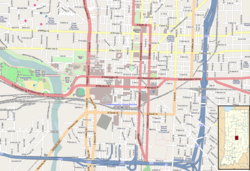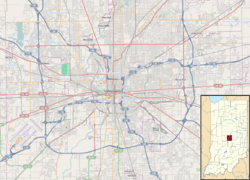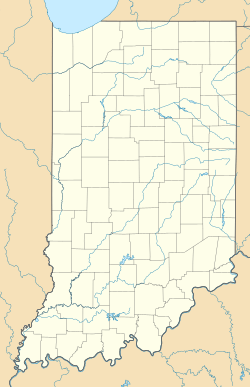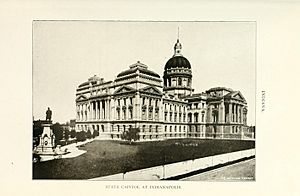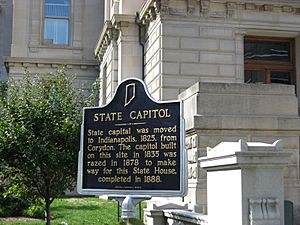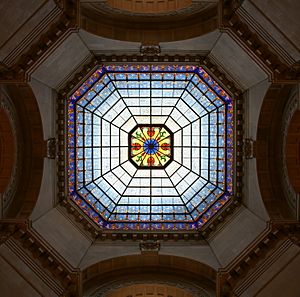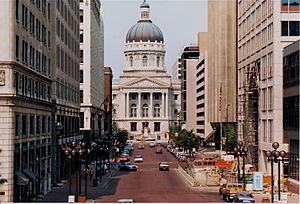Indiana Statehouse facts for kids
Quick facts for kids |
|
|
Indiana State House
|
|
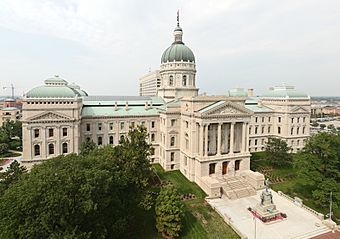
Indiana State House in Indianapolis
|
|
| Location | 200 W. Washington St., Indianapolis, Indiana 46204 |
|---|---|
| Built | 1878-1888 |
| Architect | May, Edwin; Scherer, Adolf |
| NRHP reference No. | 75000043 |
| Added to NRHP | August 28, 1975 |
The Indiana Statehouse is the main building for the government of Indiana. It is like the "headquarters" for the state. Here, you'll find the offices of the Governor of Indiana, the Indiana General Assembly (where laws are made), and the Indiana Supreme Court (where important legal decisions happen).
This important building is located in Indianapolis, the state capital. It was finished in 1888. The current Statehouse is actually the fifth building Indiana has used for its state government.
The very first statehouse is still standing in Corydon, Indiana. It is now a historic site you can visit. The second building was a courthouse in Indianapolis. The third building looked like an ancient Greek temple, but it had problems and was torn down. The current Statehouse was built in its place.
Indiana Statehouse History
The First Statehouse in Corydon
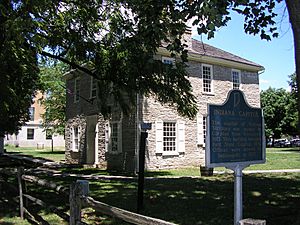
When Indiana became a state in 1816, its capital was in Corydon, Indiana. The first statehouse was a simple, two-story building made of limestone. It was built in 1813 for the Indiana Territory's government.
The building cost $1,500 to build. Citizens of Harrison County, Indiana paid for it. It was finished in three years. The building was 40 feet square with thick walls. It was one of the biggest buildings in the state at the time.
The first statehouse had only three rooms. It quickly became too small for the growing state government. More offices had to be built across the street. The lower floor was used by the Indiana House of Representatives. The top floor had rooms for the Indiana State Senate and the Indiana Supreme Court.
In 1824, the capital moved to Indianapolis. The old building was then used as a courthouse for Harrison County. Today, this old capitol building is a state historic site that people can visit.
Moving to Indianapolis: The Second Statehouse
In December 1824, the state government moved to Indianapolis. For 12 years, the government worked out of the Marion County Courthouse. This courthouse was built in 1822 with state money.
Indianapolis was a new frontier town back then. It was about 60 miles from the nearest big settlement. This made it hard to build large buildings right away.
Moving the government was a huge job. It took 11 days to travel from Corydon to Indianapolis by horseback. There were no roads, so a path had to be cut through thick forests. The move happened in winter.
A long line of wagons carried everything. This included the state's money, library books, records, and furniture. Colonel Samuel Merrill, the state treasurer, led the move. It took over a month to get everything to Indianapolis. The first meeting of the General Assembly in Indianapolis happened in January 1825.
The Greek-Inspired Third Statehouse
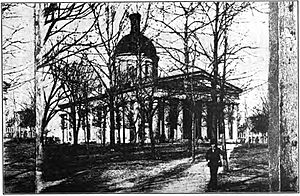
In 1831, Indiana decided to build a new State House. Money for it came from selling land in Indianapolis. A contest was held to find the best design. Architect Edwin May won $150 for his plan.
His design was inspired by the ancient Greek Parthenon. The building looked very similar, but it had a large dome in the middle. The building was finished early, in 1835.
The State House was made of blue limestone and had two stories. The governor and Supreme Court used the lower floor. The legislature used the upper floor, with each group in its own section. Many important events happened here. For example, Abraham Lincoln's body lay in state here after he died.
Over time, the building started to look old. Its limestone foundation began to crack. People worried the building might fall apart. In 1867, part of the ceiling in the House of Representatives collapsed. The building was finally torn down in 1877.
A Temporary Home: The Fourth Statehouse
When the third State House was declared unsafe in 1876, the government had to leave. The General Assembly moved into a large office building. This building was built in 1865 and already housed the Supreme Court.
The Governor and his team moved to another office building. These office buildings served as the temporary statehouse. They were used while the new, current Statehouse was being built. By 1887, parts of the new building were ready. The government moved in, even before it was fully finished.
The Current Indiana Statehouse
Building the Modern Statehouse
Indiana's population grew quickly in the mid-1800s. This meant the state government also grew. The old capitol buildings became too small. In 1865, a state office building was built for some government groups.
When the third statehouse was torn down in 1877, Indiana needed a new main building. Governor James D. Williams suggested building the current Statehouse. The Indiana General Assembly agreed in 1878. The new building was built on the same spot as the old one.
Two million dollars were set aside for the building. It was finished in 1888. Governor Williams was known for being careful with money. He completed the project for $1.8 million. He even returned $200,000 to the state!
A team of people, including Civil War General Thomas A. Morris, planned the project. Edwin May, an Indianapolis architect, designed the building. To avoid past mistakes, the new capitol had to be built on a very strong foundation. This would make sure it lasted for many years.
Construction started in 1880. The first stone was laid on September 28. Edwin May died that year, so Adolph Sherrer oversaw the rest of the building work. The inside of the building looks like Italian Renaissance style.
Workers used materials from Indiana whenever they could. The doors are made of Indiana oak. Indiana Limestone was used throughout the building. The main cornerstone is a huge 10-ton block of limestone from Spencer, Indiana. The large central dome was finished in 1883.
The building was even wired for electricity. This was before Indianapolis had its own power grid! In 1887, the new capitol was ready enough for the first legislative meeting. The building took eight years to build. It was finally finished in October 1888. At 256 feet tall, it was the second-tallest building in Indiana when it was done.
A time capsule was placed inside the cornerstone. It held 42 items. These included reports from government groups, a Bible, samples of Indiana crops, new coins, maps, newspapers, and a book about Indianapolis history.
The building is shaped like a cross. A big central rotunda with a glass dome connects the four parts. The building has four stories. The first floor holds the governor's offices. The second floor has offices for the Indiana House of Representatives and the Indiana State Senate. The Indiana Supreme Court offices are also on the second floor.
The Supreme Court Law Library, with 70,000 books, is on the third floor. This floor also has the main rooms for the House, Senate, and Supreme Court. The fourth floor has the Indiana Court of Appeals courtroom and offices for some of its judges. In front of the State House, there is a statue of Oliver Morton. He was Indiana's governor during the Civil War.
Keeping the Statehouse New: Renovations
In 1988, Governor Robert D. Orr suggested a big renovation for the Statehouse. This was part of "Hoosier Celebration '88," marking the building's 100th birthday. The General Assembly agreed. The building had a huge $11 million renovation that lasted until 1995.
During this renovation, all the stone parts, like marble and limestone, were cleaned. All the wood was fixed or replaced. Broken glass in the dome was replaced. New lights, like the original ones, were added. Most of the inside walls were repainted. The building also got a new data network. This made it ready for modern technology.
In 1984, the Indiana State House was added to the National Register of Historic Places. This means it is a special, protected building. You can take public tours of the Statehouse during the week. There are also limited tours on weekend mornings.
Art Around the Statehouse
The Indiana State House and its grounds have over 40 pieces of public art. These artworks show important people and events from Indiana's history. The art collection covers more than 130 years of different art styles.
See also
 In Spanish: Casa del Estado de Indiana para niños
In Spanish: Casa del Estado de Indiana para niños


